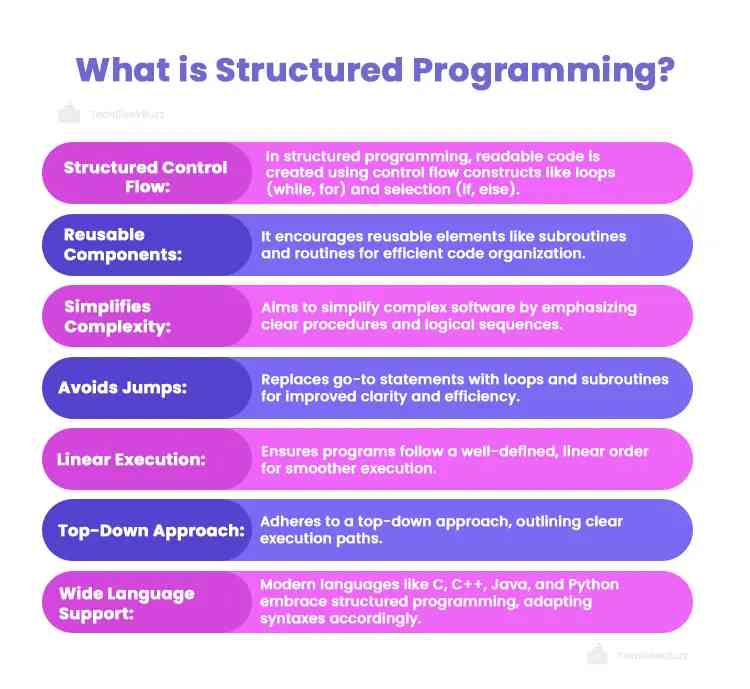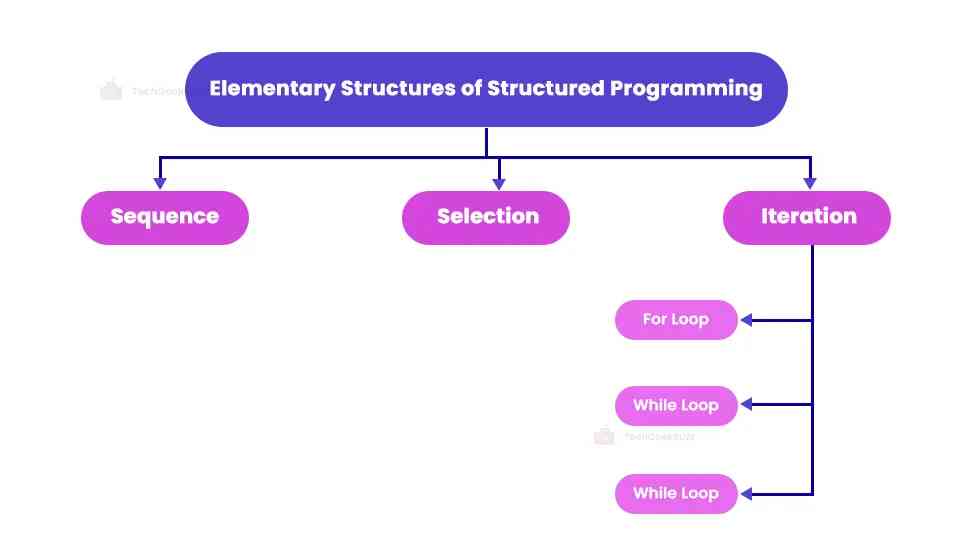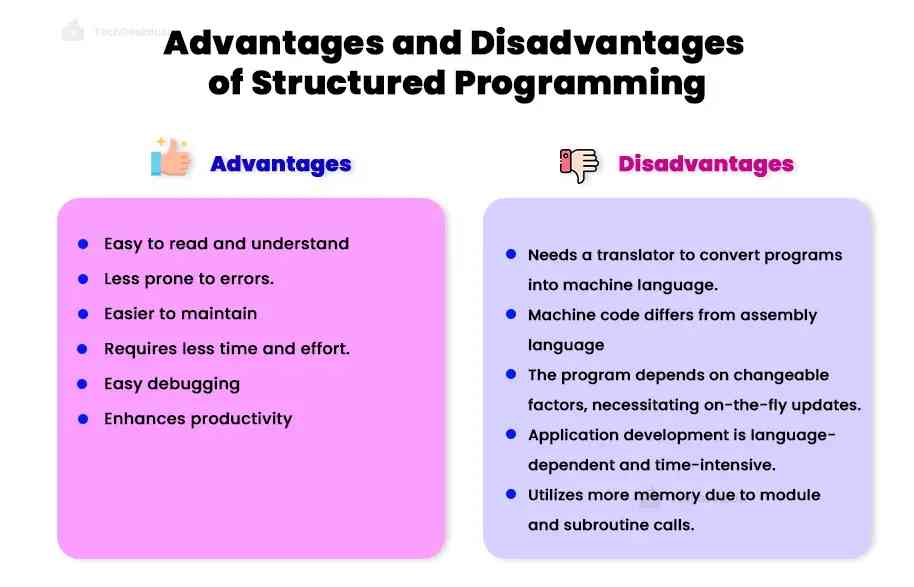Whether you are a novice or skilled programmer, you will definitely face difficulties in understanding unstructured or spaghetti code. Consider a program with over 1000 instructions. If you encounter an error while running it, it becomes challenging to locate the error due to the program’s unorganized structure.
Now, consider you encounter an error in a structured program with organized instructions. You will find it easy to locate the error and save significant time. This is where the role of structured programming comes into play.
In this article, we shall discuss structured programming in detail, along with its advantages and disadvantages.
What is Structured Programming?

Structured programming is a programming paradigm that encourages the use of structured control flow constructs to improve code readability. It refers to writing readable code with reusable components using the following structured control flow constructs:
- Repetition (while and for loop)
- Selection (if and else)
- Subroutines
- Block structures
Features of Structured Programming
- This programming paradigm came into existence in the later 1950s with the advent of ALGOL 58 and ALGOL 60 programming languages.
- It is the superset of procedural programming. Procedural programming encourages using procedures, such as routines, subroutines, or functions, containing a series of sequential instructions.
- It aims to simplify the understanding of complex software and its underlying programs, files, and procedures.
- It requires programmers to use subroutines and loops rather than using jumps (go-to statements). This adds more clarity to the software’s source code and makes it efficient for execution.
- All modern programming languages, such as C, C++, Java, C#, Python, etc., support this programming paradigm. However, the way these languages support varies due to their varying syntaxes.
- The execution of the program follows the order in which it is written. This implies structured programming follows the top-down approach.
Further, assembly languages, like Microprocessor 8085, use jump statements, like go-to. These statements transfer the flow of control to a random set of instructions (a code block) in a program. Hence, a program does not get executed in a structured or linear order.
Structured programming linearizes the flow of control through a program. This means all the operations and execution paths in the program follow a well-defined order.
In short, programmers can easily organize their code using structured programming and reduce their coding time and effort.
Elementary Structures of Structured Programming
There are three elementary structures of structured programming, as follows:

1. Sequence
A sequence is an ordered arrangement of instructions, subroutines, or statements. It has a single entry (the first line of a program) and exit (the last line of a program) point.
The sequence is executed in a linear fashion. It starts executing the statements from top to bottom, similar to how they are written.
Example
Read input from a user → Perform calculations → Display the result to the user.
2. Selection
Selection refers to executing blocks of code based on the outcome of a condition. It involves the use of the keywords called conditional statements, such as if, then, else, and endif.
If the specified condition with the “if” statement holds true, the control flow moves to statements present in that block. Otherwise, the control flow moves to the ‘else’ block.
Example
if (condition)
//code block
else
//code block
endif
3. Iteration
An iteration repeatedly executes a block of code a certain number of times or as long as the condition is met. We use ‘for,’ ‘while,’ and ‘do-while’ loops to iterate a specific block of code.
With the ‘for’ loop, it is possible to specify the number of times you want to execute a code block. It requires you to specify the condition in the beginning. The same goes for the while loop. However, the do-while loop evaluates the condition at the end of the code block.
Example
- For Loop
for (variable initialization; condition; increment/decrement)
{
//code block
}
- While Loop
while (condition)
{
//code block
}
- Do-While Loop
do
{
//code block
}while (condition);
Some Other Major Concepts
-
Top-Down Approach
The top-down approach refers to breaking down a large problem into smaller ones and solving each small problem independently.
In programming, the top-down approach breaks down a large program into smaller functional blocks of code. These code blocks can accept input, perform a specific task, and provide the output. This helps programmers execute a large program efficiently.
-
Subroutines (Modular Programming)
Subroutines are the functions, methods, procedures, or subprograms containing a set of sequential instructions to perform a specific task. It is possible to use a subroutine repeatedly in a program. Each subroutine can work independently.
For instance, consider you write a subroutine to add two numbers. You can use this subroutine anywhere in a program where there is a need to add two numbers. The best real-time example of this is a calculator.
Types of Structured Programming
Structured programming is categorized into three types – Procedural, Object-oriented, and Model-based.
1. Procedural Programming
Procedural programming encourages the use of procedures (subroutines or functions) to perform computations. A procedure is any function, routine, or subroutine containing a sequence of instructions or sequential steps to be performed.
It is possible to call any procedure in a program at any given point during the program execution. Procedural programming follows the top-down approach.
A program in procedural programming consists of two separate entities – data and functions/procedures working on that data. FORTRAN and ALGOL are two early procedural programming languages.
2. Object-Oriented Programming
Object-oriented programming is a widely used paradigm that organizes a program or software into objects rather than functions and logic. An object contains data and code. The data is present in the form of attributes or properties, while the code is in the form of procedures (methods or functions).
The primary goal of object-oriented programming is to combine data and procedures working on that data. No other functions or part of the code can access that data.
3. Model-Based Programming
Database programming languages, like SQL, are the best examples of model-based programming. Every unit of code in a database programming language is associated with the steps to access or update a database.
Advantages and Disadvantages of Structured Programming
Here are some significant advantages and disadvantages of structured programming:

Advantages
- Programs are easy to read and understand.
- They are less prone to errors.
- They are easier to maintain
- Writing code using structured programming requires less time and effort.
- Locating errors and debugging them is easy.
- Structured programming enhances the productivity of the development team.
- Most high-level programming languages support this paradigm.
- Programs following this programming paradigm are mostly machine-independent. This means programs written on one computer can run on any other computer.
Disadvantages
- As it is machine-independent, we need a translator to convert it into machine language.
- The machine code does not match the assembly language code.
- The program depends upon changeable factors, like data types. Therefore, it needs to be updated with the need on the go.
- Developing applications using this approach takes time, as it is language-dependent. This is not the case with assembly languages, as they are pre-programmed for machines.
- It results in greater memory usage due to the use of calls to modules and subroutines.
Conclusion
That sums up structured programming. It is a programming paradigm that enforces the use of structured control flow constructs to improve the readability and clarity of code. It helps programmers easily locate errors even in a program of over 1000 lines of code. Also, it reduces the time required to write a large program or complex software.
Hope you have built a better understanding of the programming paradigm now. Have any queries for us? Drop the same in the comments section below.
Happy programming!
People are also reading:
![What is Structured Programming? [Definition, Pros, and Cons]](/media/new_post_images/What-is-Structured-Programming.webp)




Leave a Comment on this Post